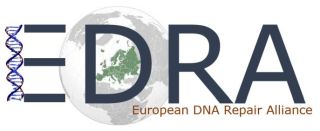|
|
|
Previous webinars > 1st Webinar 09/21/20211st EDRA Webinar Sept. 21st, 2021, from 4.30 to 6 pm CET
Dr Neil KAD - School of Biosciences, University of Kent, UK
Revealing the molecular basis of DNA repair using single molecule techniques In this talk I will discuss a number of studies performed in our laboratory that begin to shed light on the complex physical relationships between the machines of DNA repair and their substrates. We have investigated how UV damage is resolved in bacteria by studying individual molecules suspended between pedestals above a microscope coverslip surface, this in vitro approach combined with bulk-phase kinetic analysis reveals how UvrA uses its ATPase to guide repair. In addition, we have studied this process in vivo at the single molecule level to reveal that NER might also be involved in resolving mis-incorporation at replication forks. These studies highlight the importance of using single molecule methods to study complex protein pathways, and how using these approaches we can learn new unexpected mechanistic facets of their biology.
Short 15-min talks: 1. Aurele PIAZZA - École Normale Supérieure de Lyon, France Cohesin regulates homology search during recombinational DNA repair Homologous recombination (HR) is an ubiquitous DNA double-strand break (DSB) repair mechanism. It entails a homology search step, carried out along a conserved RecA/Rad51-ssDNA nucleoprotein filament (NPF) assembled on each DSB ends. In contrast to the extensive knowledge of DNA damage checkpoint (DDC)-induced changes in chromatin composition and mobility, the questions of if, how, and to what extent a DSB impacts the spatial organization of chromatin, and whether this organization in turn influences the homology search process, remain ill-defined. Here we characterize two layers of spatial chromatin reorganization following DSB formation in S. cerevisiae. While cohesin folds chromosomes into cohesive arrays of ~20 kb-long chromatin loops as cells arrest in G2/M, the DSB-flanking regions interact locally in a resection- and 9-1-1 clamp-dependent manner, independently of cohesin, Mec1ATR, Rad52 and Rad51. This local structure blocks cohesin progression, constraining the DSB region at the base of a loop. Functionally, cohesin promotes DSB-dsDNA interactions and donor identification in cis, while inhibiting them in trans. This study identifies multiple direct and indirect ways by which cohesin regulates homology search during HR repair. 2. Ostiane d'AUGUSTIN - University of Rennes, France How does DNA-glycosylase OGG1 find 8-oxoguanine within the genome? The DNA-glycosylase OGG1 is in charge of the recognition and excision of 8-oxoguanine (8-oxoG). It has been extensively studied in vitro or after global chemical stress in living cells. Although these studies made important insights regarding the function of OGG1, they do not allow to get access to the dynamics of the excision process in living cells. During this talk, I will present my PhD work which aims at elucidating the mechanisms underlying the rapid detection of 8-oxoG by OGG1 within the complex nuclear space, as well as the efficient processing of this lesion by the DNA-glycosylase. I will focus in particular on the roles of specific OGG1 residues supposed to be involved in these different steps of the DNA repair process. |



